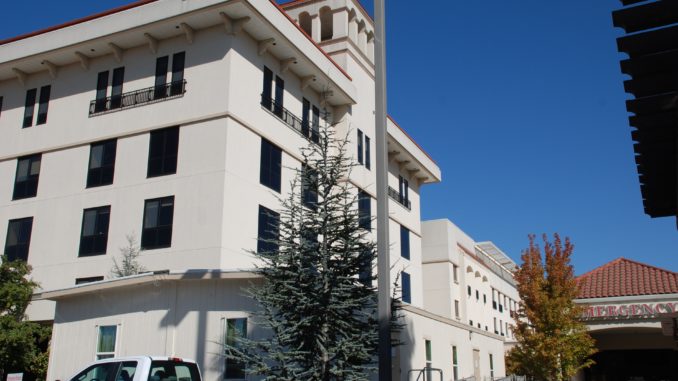
When Enloe Medical Center recently announced the termination of its Medi-Cal Managed Care contract with Anthem Blue Cross—which will impact 1 in 10 Butte County residents when it takes effect Nov. 1—the news evoked vivid deja vu.
The hospital and health insurer hit the same impasse in negotiations exactly two years ago over reimbursements for services to patients with privately paid Anthem plans. The Camp Fire prompted the sides to extend their previous agreement—multiple times—until they finally sealed a new deal in May 2019.
Anthem had similar brinksmanship negotiations with primary care practitioners in Chico, such as the doctors at Argyll Medical Group—which, like Enloe, terminated its contract, four years ago, before coming to terms with the private insurer. Anthem also was the late insurance company holdout to cover 3-D mammography for detecting breast cancer (as detailed in the CN&R’s 2017 feature story “Chico vs. The Man”).
So, once Enloe deadlocked with Anthem last month, it already had history as a guide.
The parties diverge again on dollars. Enloe contends it deserves better rates than Anthem offered—pointing to the higher amount the hospital received this year from the other provider of Medi-Cal Managed Care policies, California Health and Wellness. Anthem contends Enloe deserves less than that, citing comparable costs of hospitals elsewhere.
California Health and Wellness, part of the multi-state managed care firm Centene, covers roughly two-thirds of Butte County’s managed Medi-Cal patients. That still leaves around 22,500 with Anthem Blue Cross. Barring a last-minute change in negotiations—which, as of Thursday (Oct. 22), had not occurred—these people either will need to change plans or look beyond the county’s most comprehensive hospital for care. Medi-Cal patients already struggle with access to primary care, let alone more advanced treatment, in a region faced with a shortage of medical providers.
“We have learned over the years that unless we convey our intent to not renew a contract with any individual insurance plan that they just ignore us, because the contract would roll over into the next contract period and we could never get them to the table,” Enloe CEO Mike Wiltermood told the CN&R by phone. The medical center let Anthem know its intent in May.
“Since we’ve negotiated with Anthem, all they’ve said to us is, ‘We’re getting our funding cut from the state, so we want you to discount services further’—they want to cut,” Wiltermood continued. “It doesn’t make any sense to us: If California Health and Wellness was able to offer [more], why isn’t Anthem offering the same amount [from the same kind of policies]?
“We’re not sure if it’s a corporate-wide negotiating tactic, but they tend to wait until the last minute, and they’re not very good at informing their enrollees [whether] they have no intention of renegotiating the contract, so we felt obligated to make a public announcement that the contract was going to expire Oct. 31.”
Enloe made that announcement Sept. 18, noting that Medi-Cal patients receiving “active treatment” and “preauthorized care” might be able to continue doing so at the medical center after the expiration depending on terms of the insurer. (This does not affect other Anthem Blue Cross subscribers.)

Anthem Blue Cross spokesman Michael Bowman responded to the CN&R with a statement: “It’s disappointing that in the midst of an ongoing pandemic Enloe Medical Center would signal its intent to terminate its Medi-Cal hospital contract with us. Consumers need stability and continued access to affordable health care services.
“Also, high rates such as those demanded by Enloe place a cost burden on California taxpayers at a time when healthcare affordability is more critical than ever. Left unchecked these high rates are not only a burden, but they threaten the sustainability of the Medi-Cal program.
“Anthem Blue Cross remains committed to working in good faith to negotiate a new agreement, while being good stewards of public dollars, and we hope Enloe shares that commitment and will put the needs of consumers, taxpayers and the community first.”
Balance sheet
Anthem’s position stems from several points. The federal Centers for Medicare and Medicaid Services report that hospitals lead the increase in health-care costs. Enloe’s pricing for reimbursement, according to a study by the Rand Corporation, figures at 213 percent of standardized national Medicare rates—compared to 182 percent for Oroville Hospital and 269 percent for California as a whole.
Enloe points to different accounting: costs in the North State versus corporate profits. Serving rural areas in and around Butte County, Enloe draws a majority of patients with Medicare or Medi-Cal as insurance, as well as uninsured into the emergency room.
The nonprofit hospital lost $32 million between March and June when, per government mandate, it set aside half its space for a potential coronavirus surge and suspended all elective procedures (that is, treatments and surgeries for conditions that weren’t life-threatening). Chief Financial Officer Kevin Woodward said the loss stands at $12 million following governmental funding, such as for operating the Federal Medical Station at the Enloe Rehabilitation Center this spring and a Medicare subsidy, for all hospitals, to offset the pandemic response.
Meanwhile, Anthem’s profits doubled in the second quarter of 2020, to $2.3 billion on $29.4 billion revenue, when the pandemic prompted patients to stay away from medical facilities—thus, not filing claims yet still paying premiums. Analysts expect another $30 billion in earnings for the third quarter, a 13 percent increase over last year.
“We don’t expect the losses that we’re sustaining—that all hospitals around the country have sustained as a result of the pandemic—to figure into this contract,” Wiltermood said. “We’re just trying to get parity with the other company so that neither one has a competitive advantage over the other and we’re getting what’s at least a reasonable amount under the contracts.”
Dr. Roy Bishop, CEO of Argyll Medical Group, shares that view. While not negotiating during a pandemic, he found himself at odds with Anthem when comparing reimbursement rates offered for Blue Cross to other insurance companies. A past critic of the hospital, he’s not in this instance.
“Enloe has fixed costs, and I think they’re being as efficient as they can be,” Bishop said. “Anthem always comes from the position that they’re trying to minimize their cost. Of course, they say they’re trying to do it for the benefit of their patients and shareholders, but they do have to pay adequately and fairly to cover the cost of doing business in a place like Butte County.”
Moving forward
Managed Medi-Cal plans consolidate patients into networks of providers, oriented toward primary care and preventative care. The system covers all 58 California counties and 10.8 million people, and hasestablished different coverage offerings in different places. California Health and Wellness/Centene and Anthem have exclusivity for Butte County.
Wiltermood and Woodward said they plan to continue negotiating with Anthem, hoping to resolve the situation before the contract expires. In the meantime, Enloe is assisting patients who wish to change their enrollment to California Health and Wellness.
“In this particular case, we’re kind of figuring that if Anthem doesn’t want a contract with us, we’re prepared for that,” Wiltermood said. “We understand it will be an inconvenience for some of their enrollees, and we may actually have an increase in denials for care provided until people transfer over to California Health and Wellness, but it’s just a pattern that we’ve seen.
“Even during the Camp Fire, Anthem came to the table and said, ‘Look, we know you guys are really in a bad spot, the community’s suffering, we want to make sure that this negotiation goes smoothly, we’re here to help’—and what did it take, another four, five months to get the contract negotiated? It was silly, and we wound up basically where we expected to wind up at the end of the day, and it took months and months to get there.
“So we’re kind of expecting the same kind of deal.”




Be the first to comment